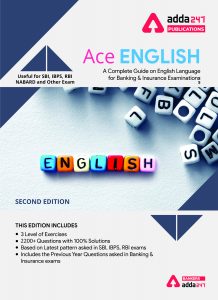Directions (1-7): In the following passage, some of the words have been left out, each of which is indicated by a number. Find the suitable word from the options given against each number and fill up the blanks with appropriate words to make the paragraph meaningfully complete.
Q1. India has a young population ___(1)__ a median age of 27.6 years. Therefore, unlike in most developed countries and China, problems of the elderly, of the kind discussed in a recent __(2)___ of ageing by the Economist, are not a hot-button public policy issue. But that would ___(3)___ the higher proportion of the elderly in the southern states and among __(4)___ sections elsewhere.
While the under-14s account for 28% of India’s population, about 66% are in the age group 15-65. That leaves 6% of the population who are 65-plus. The potential support ratio, the number of working age persons per senior citizen is thus 11, a far cry from Japan’s 2.1. But, while the problem lacks urgency, this is the right time to act. By __(5)____ the National Pension System’s architecture of funded pensions while the country is still young, India has chosen to avoid the problems that befall a pay-as-you-go system of pensions when the working population ____(6)____ in relation to that of the elderly who do not work. Similar prudential action is required in other _(7)____ fronts.
(a) consisting
(b) with
(c) in
(d) contains
(e) have
Q2. India has a young population ___(1)__ a median age of 27.6 years. Therefore, unlike in most developed countries and China, problems of the elderly, of the kind discussed in a recent __(2)___ of ageing by the Economist, are not a hot-button public policy issue. But that would ___(3)___ the higher proportion of the elderly in the southern states and among __(4)___ sections elsewhere.
While the under-14s account for 28% of India’s population, about 66% are in the age group 15-65. That leaves 6% of the population who are 65-plus. The potential support ratio, the number of working age persons per senior citizen is thus 11, a far cry from Japan’s 2.1. But, while the problem lacks urgency, this is the right time to act. By __(5)____ the National Pension System’s architecture of funded pensions while the country is still young, India has chosen to avoid the problems that befall a pay-as-you-go system of pensions when the working population ____(6)____ in relation to that of the elderly who do not work. Similar prudential action is required in other _(7)____ fronts.
(a) reports
(b) opinion
(c) trial
(d) survey
(e) rating
Q3. India has a young population ___(1)__ a median age of 27.6 years. Therefore, unlike in most developed countries and China, problems of the elderly, of the kind discussed in a recent __(2)___ of ageing by the Economist, are not a hot-button public policy issue. But that would ___(3)___ the higher proportion of the elderly in the southern states and among __(4)___ sections elsewhere.
While the under-14s account for 28% of India’s population, about 66% are in the age group 15-65. That leaves 6% of the population who are 65-plus. The potential support ratio, the number of working age persons per senior citizen is thus 11, a far cry from Japan’s 2.1. But, while the problem lacks urgency, this is the right time to act. By __(5)____ the National Pension System’s architecture of funded pensions while the country is still young, India has chosen to avoid the problems that befall a pay-as-you-go system of pensions when the working population ____(6)____ in relation to that of the elderly who do not work. Similar prudential action is required in other _(7)____ fronts.
(a) negate
(b) abrogate
(c) despise
(d) ignore
(e) provoke
Q4. India has a young population ___(1)__ a median age of 27.6 years. Therefore, unlike in most developed countries and China, problems of the elderly, of the kind discussed in a recent __(2)___ of ageing by the Economist, are not a hot-button public policy issue. But that would ___(3)___ the higher proportion of the elderly in the southern states and among __(4)___ sections elsewhere.
While the under-14s account for 28% of India’s population, about 66% are in the age group 15-65. That leaves 6% of the population who are 65-plus. The potential support ratio, the number of working age persons per senior citizen is thus 11, a far cry from Japan’s 2.1. But, while the problem lacks urgency, this is the right time to act. By __(5)____ the National Pension System’s architecture of funded pensions while the country is still young, India has chosen to avoid the problems that befall a pay-as-you-go system of pensions when the working population ____(6)____ in relation to that of the elderly who do not work. Similar prudential action is required in other _(7)____ fronts.
(a) superfluous
(b) affluent
(c) auxiliary
(d) liberal
(e) extreme
Q5. India has a young population ___(1)__ a median age of 27.6 years. Therefore, unlike in most developed countries and China, problems of the elderly, of the kind discussed in a recent __(2)___ of ageing by the Economist, are not a hot-button public policy issue. But that would ___(3)___ the higher proportion of the elderly in the southern states and among __(4)___ sections elsewhere.
While the under-14s account for 28% of India’s population, about 66% are in the age group 15-65. That leaves 6% of the population who are 65-plus. The potential support ratio, the number of working age persons per senior citizen is thus 11, a far cry from Japan’s 2.1. But, while the problem lacks urgency, this is the right time to act. By __(5)____ the National Pension System’s architecture of funded pensions while the country is still young, India has chosen to avoid the problems that befall a pay-as-you-go system of pensions when the working population ____(6)____ in relation to that of the elderly who do not work. Similar prudential action is required in other _(7)____ fronts.
(a) commencing
(b) accomplishing
(c) effecting
(d) executing
(e) creating
Q6. India has a young population ___(1)__ a median age of 27.6 years. Therefore, unlike in most developed countries and China, problems of the elderly, of the kind discussed in a recent __(2)___ of ageing by the Economist, are not a hot-button public policy issue. But that would ___(3)___ the higher proportion of the elderly in the southern states and among __(4)___ sections elsewhere.
While the under-14s account for 28% of India’s population, about 66% are in the age group 15-65. That leaves 6% of the population who are 65-plus. The potential support ratio, the number of working age persons per senior citizen is thus 11, a far cry from Japan’s 2.1. But, while the problem lacks urgency, this is the right time to act. By __(5)____ the National Pension System’s architecture of funded pensions while the country is still young, India has chosen to avoid the problems that befall a pay-as-you-go system of pensions when the working population ____(6)____ in relation to that of the elderly who do not work. Similar prudential action is required in other _(7)____ fronts.
(a) shrinks
(b) mitigates
(c) undermines
(d) disables
(e) restrains
Q7. India has a young population ___(1)__ a median age of 27.6 years. Therefore, unlike in most developed countries and China, problems of the elderly, of the kind discussed in a recent __(2)___ of ageing by the Economist, are not a hot-button public policy issue. But that would ___(3)___ the higher proportion of the elderly in the southern states and among __(4)___ sections elsewhere.
While the under-14s account for 28% of India’s population, about 66% are in the age group 15-65. That leaves 6% of the population who are 65-plus. The potential support ratio, the number of working age persons per senior citizen is thus 11, a far cry from Japan’s 2.1. But, while the problem lacks urgency, this is the right time to act. By __(5)____ the National Pension System’s architecture of funded pensions while the country is still young, India has chosen to avoid the problems that befall a pay-as-you-go system of pensions when the working population ____(6)____ in relation to that of the elderly who do not work. Similar prudential action is required in other _(7)____ fronts.
(a) developing
(b) raising
(c) evolving
(d) ageing
(e) mollifying
Directions (8-10): In each question below a sentence with four words printed in bold type is given. These are numbered as (a), (b), (c) and (d). One of these four words printed in bold may be either wrongly spelt or inappropriate in the context of the sentence. Find out the word which is wrongly spelt or inappropriate if any. The number of that word is your answer. If all the words printed in bold are correctly spelt and also appropriate in the context of the sentence, mark (e) i.e. ‘All correct’ as your answer.
Q8. Under existing (A) / regulations we are not permitted (B) / to owe (C) / more than a forty percent share (D) / of the family business. All correct (E).
(a) existing
(b) permitted
(c) owe
(d) share
(e) All correct
Q9. In case of any land dispute (A) / panchayat officials (B) / will determine (C) / how the property is to be dividend (D) / All correct (E).
(a) dispute
(b) officials
(c) determine
(d) dividend
(e) All correct
Q10. The World Bank has deviated (A) / to sanction (B) / the necessary (C) / finance (D) / for the project. All correct (E).
(a) deviated
(b) sanction
(c) necessary
(d) finance
(e) All correct
Solutions
S1. Ans. (b)
Sol. “with” is the correct preposition as it is used in the connection of having or possessing (something). If we go by the sentence structure, it can be sensed that the gap requires a preposition than a verb. Hence (b) is the correct option.
S2. Ans. (d)
Sol. “survey” is the correct word to fill the gap as it means an investigation of the opinions or experience of a group of people, based on a series of questions. Others words form the familiarity with it but are not in context of the meaning of the sentence. Hence (d) is the correct option.
S3. Ans. (d)
Sol. “ignore” is the most appropriate word in context of its meaning to the sentence as it means fail to consider (something significant). Hence (d) is the correct option.
S4. Ans. (b)
Sol. “affluent” is the correct word to fill the gap as it means (especially of a group or area) having a great deal of money; wealthy. Other words alter the meaning of the sentence. Hence (b) is the correct option.
S5. Ans. (e)
Sol. “creating the National Pension System’s architecture of funded pensions” makes the correct phrase in context of its meaning to the sentence. Hence (e) is the correct option.
S6. Ans. (a)
Sol. “shrinks” is the correct word as it means become or make smaller in size or amount. Other words are irrelevant in adding any meaning to the sentence.
S7. Ans. (d)
Sol. “ageing” is the correct word as it can be inferred after reading the complete passage. The theme of the paragraph revolves around the word which means (of a person) growing old; elderly. Hence (d) is the correct option.
S8. Ans.(e).
Sol. All the given words are correct.
S9. Ans.(d)
Sol. Use ‘divided’ instead of ‘dividend’.
S10. Ans.(a)
Sol. Use ‘agreed’ instead of ‘deviated’.





 English Language Quiz For Bank Foundatio...
English Language Quiz For Bank Foundatio...
 English Language Quiz For Bank Mains Exa...
English Language Quiz For Bank Mains Exa...


